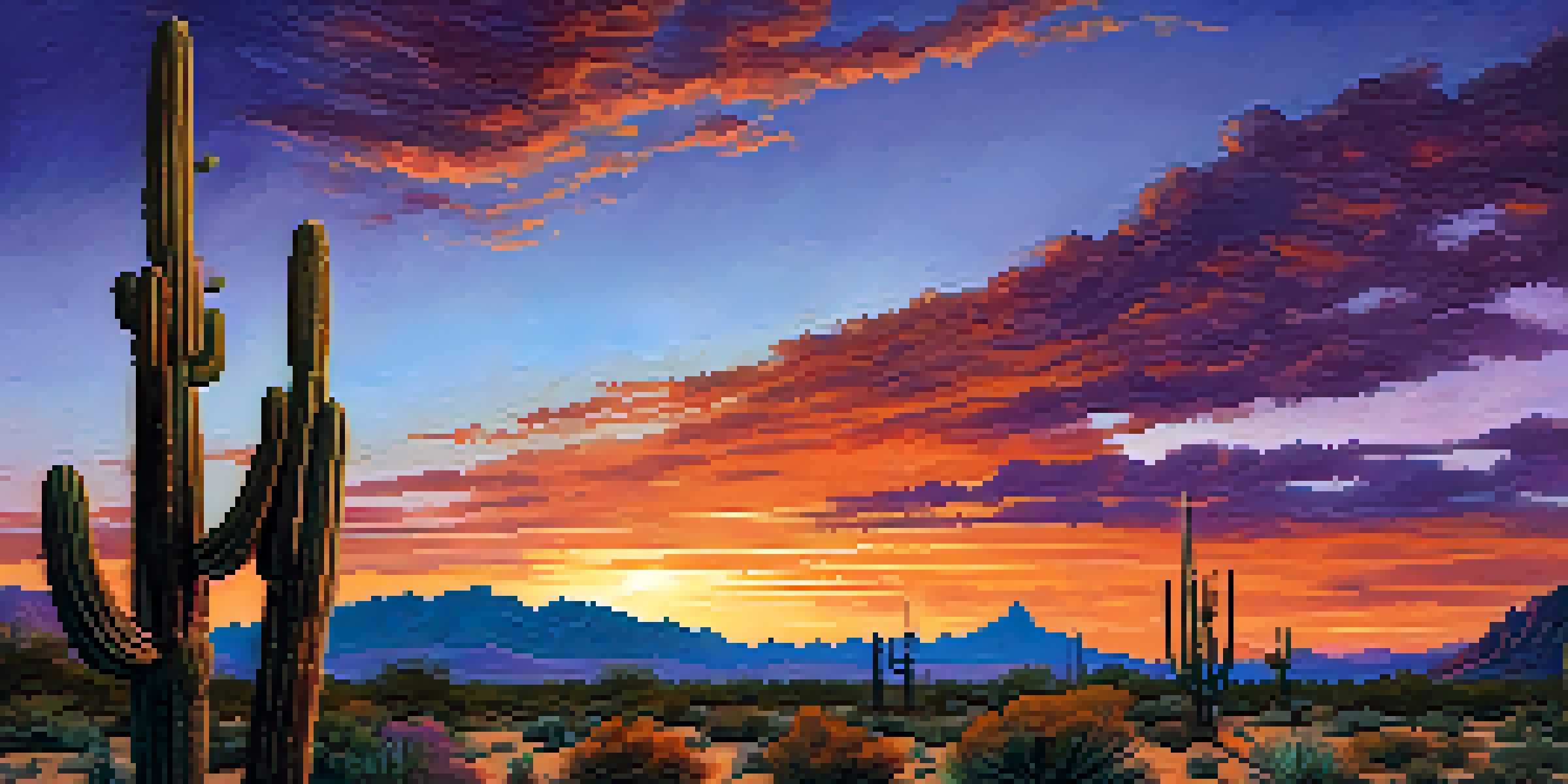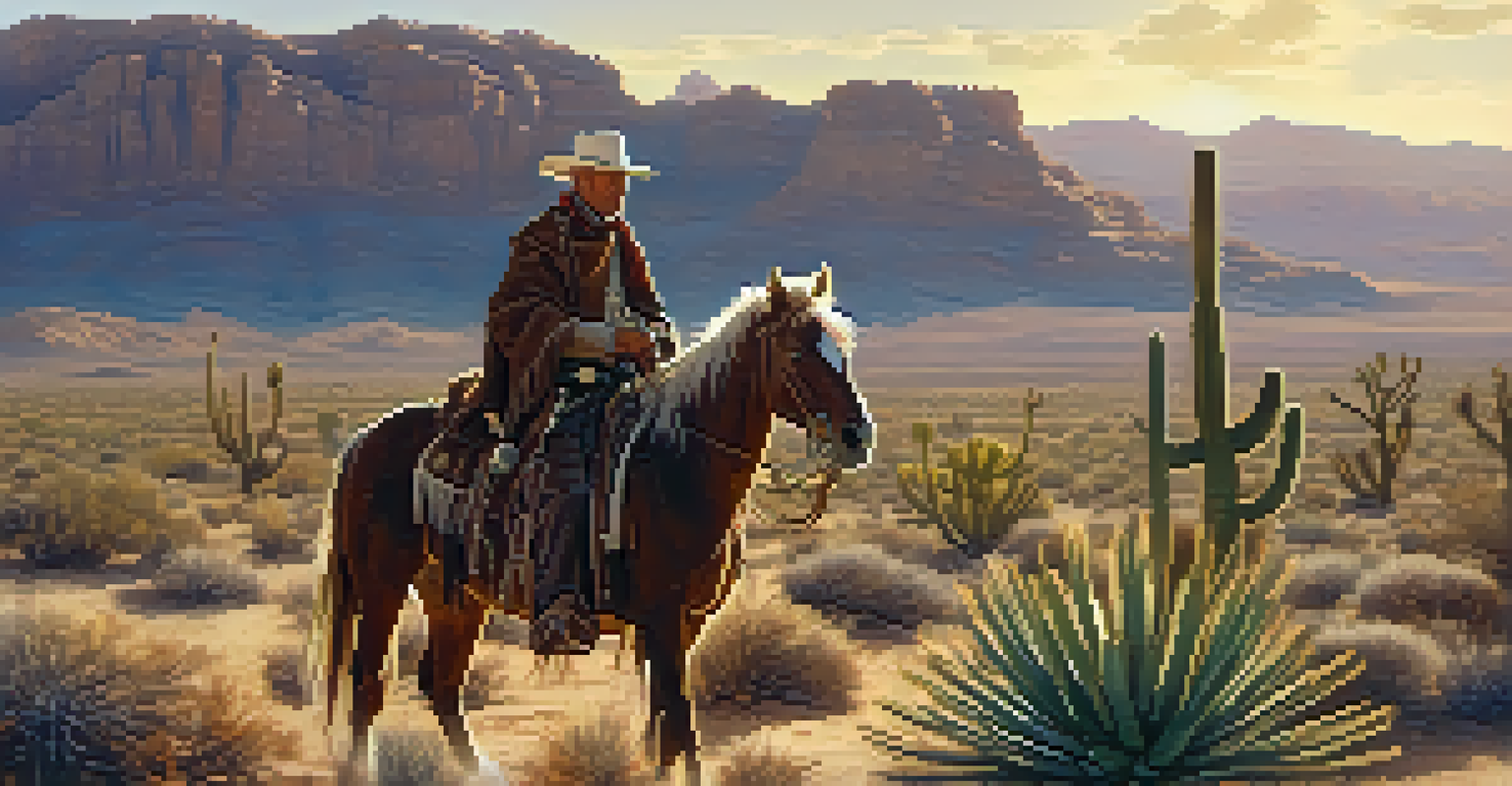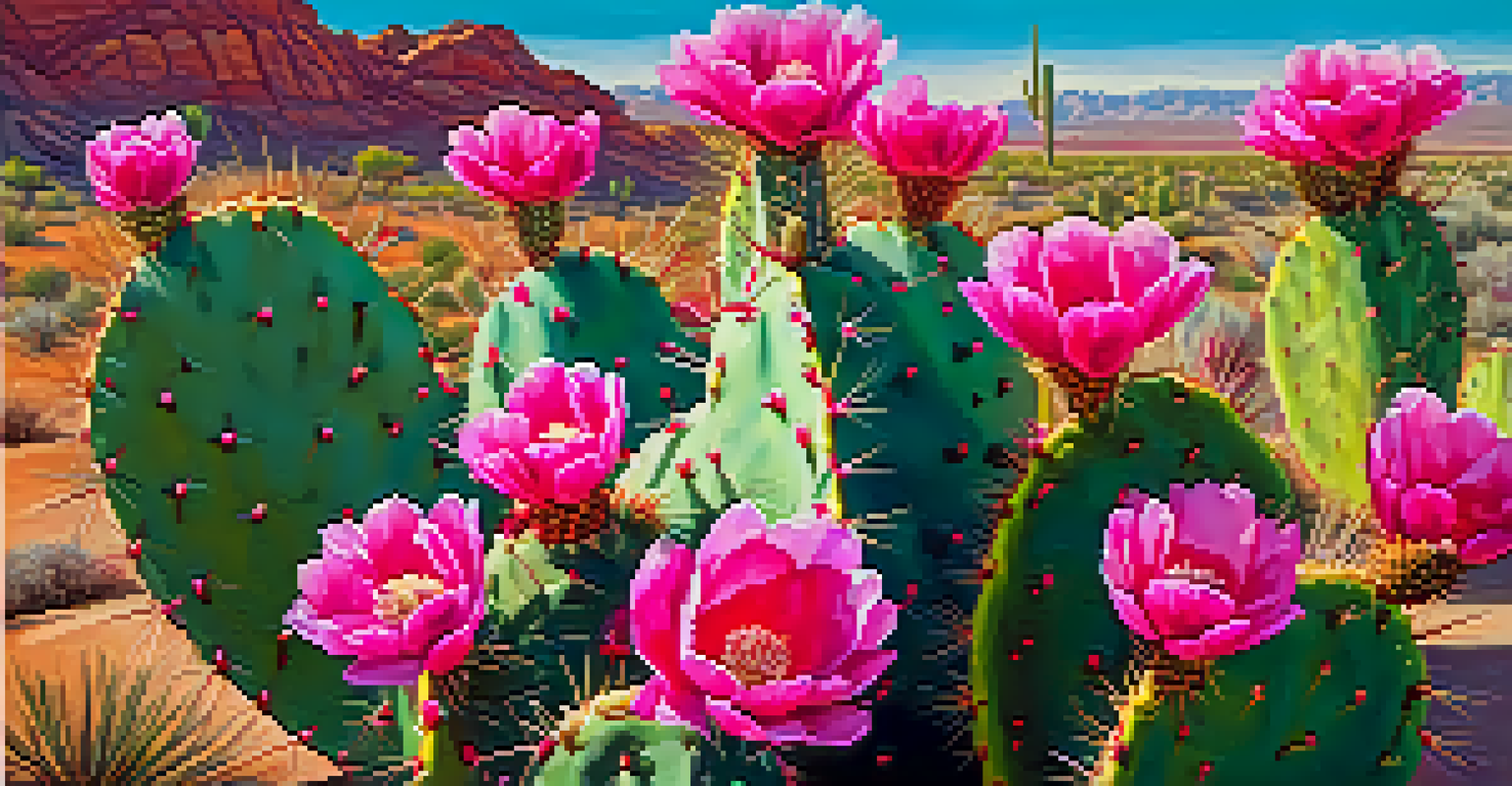Cactus and Cowboys: Symbols of Arizona in Western Stories

The Cactus: Nature's Resilient Survivor
Cacti are not just plants; they symbolize survival and resilience in Arizona's harsh desert environment. With their unique ability to thrive in extreme heat and arid conditions, these remarkable plants have become synonymous with the state. Just like the cowboys who roam the rugged landscapes, cacti illustrate the strength and tenacity needed to endure life's challenges.
In the desert, there is no sign of life, yet the cactus thrives. It teaches us that survival comes from within, no matter how harsh the environment.
In Western stories, cacti often serve as both setting and character, providing shelter for weary travelers and a stark reminder of the wilderness. Their towering silhouettes against the sunset create a striking image that captures the spirit of the American West. Whether it's a lonely saguaro standing tall or a cluster of prickly pear, each cactus tells a story of survival.
Moreover, the cactus's ability to store water represents hope in desolate times, mirroring the cowboy's perseverance in the face of adversity. In many tales, these plants become symbols of both struggle and triumph, making them vital elements in the narrative tapestry of Arizona’s folklore.
Cowboys: The Iconic Figures of the West
Cowboys are perhaps the most recognizable symbols of the American West, embodying freedom, adventure, and rugged individualism. Their portrayal in literature and films often romanticizes the life of a rancher, complete with horseback riding, cattle wrangling, and a deep connection to the land. These characters are rooted in real history, reflecting a lifestyle that is both challenging and rewarding.

In Arizona, cowboys are often depicted as heroes in tales of bravery and resourcefulness. They navigate the vast landscapes, facing both natural and human adversities, which further cements their legendary status. The cowboy's connection to nature, especially the cacti that populate their environment, enhances their role as guardians of the land.
Cacti Symbolize Resilience
Cacti represent survival and hope in Arizona's harsh desert, mirroring the strength needed to overcome life's challenges.
The stories we associate with cowboys often highlight themes of loyalty, friendship, and the pursuit of justice. Whether they’re helping a neighbor in need or standing up to bandits, these narratives resonate with audiences and reinforce the cowboy's place as a beloved figure in Western lore.
Cacti and Cowboys: A Symbolic Relationship
The relationship between cacti and cowboys goes beyond mere coexistence; it represents a broader theme of adaptation and survival in the harsh Arizona landscape. Cowboys rely on their knowledge of the land, including the survival skills imparted by the cactus. Just as cowboys learn to navigate the wild, cacti demonstrate the importance of resilience in the face of adversity.
A cowboy is a man who does what he can, with what he has, where he is.
In many Western stories, the presence of cacti evokes a sense of place and authenticity. They serve as landmarks for cowboys as they traverse the desert, adding depth and atmosphere to the narrative. This relationship illustrates how elements of nature can shape human experiences and stories, creating a vivid backdrop for adventure.
Furthermore, the duality of beauty and danger found in cacti mirrors the cowboy's life. While the desert can be breathtaking, it also presents challenges, much like the life of a cowboy. This interplay adds complexity to both the characters and the landscape, enriching the stories that emerge from Arizona.
Cacti in Western Art and Culture
Cacti have inspired countless artists and writers, becoming prominent symbols in Western art and culture. From paintings to poetry, these plants evoke themes of solitude, resilience, and the stark beauty of the desert. Artists capture their unique shapes and vibrant colors, connecting viewers to the essence of Arizona's landscape.
In literature, cacti often appear as metaphors for emotional states, reflecting the inner struggles of characters. Just as a cactus must endure harsh conditions to thrive, so too must individuals navigate life's challenges. This symbolism deepens the connection between the environment and personal narratives, making cacti integral to the storytelling process.
Cowboys Embody Adventure
Cowboys are iconic figures of the American West, symbolizing freedom, bravery, and a deep connection to the land.
Additionally, cacti are celebrated in festivals and cultural events across Arizona, showcasing their significance in local traditions. These celebrations highlight the enduring relationship between the land and its people, fostering a sense of community and appreciation for the natural world.
Cowboys in Music and Storytelling
The cowboy lifestyle has long been a source of inspiration for musicians and storytellers alike. From classic country songs to contemporary ballads, the themes of love, loss, and adventure resonate deeply with audiences. These musical narratives often weave in elements of the Arizona landscape, including the iconic cactus, creating a rich tapestry of sound and story.
Storytelling traditions, such as tall tales and anecdotes, further immortalize the cowboy experience. These narratives often blend fact and fiction, painting a larger-than-life picture of cowboys navigating the rugged terrain. The cactus serves as a backdrop for these stories, enhancing their vivid imagery and emotional depth.
Through music and storytelling, the cowboy's journey becomes a shared experience, allowing listeners to connect with the struggles and triumphs of these iconic figures. This cultural exchange keeps the spirit of the cowboy alive, ensuring that their legacy is celebrated for generations to come.
Modern Interpretations of Cacti and Cowboys
Today, cacti and cowboys continue to inspire modern artists and writers. As society evolves, so too does the portrayal of these symbols, reflecting contemporary values and challenges. New narratives explore themes of sustainability and environmentalism, highlighting the importance of preserving both the land and its cultural heritage.
In popular media, we see a shift in how cowboys are depicted, often emphasizing inclusivity and diversity. This modern interpretation challenges traditional stereotypes, showcasing a broader spectrum of cowboy experiences. Cacti remain a constant, serving as a reminder of the enduring connection to the land and the stories that arise from it.
Cacti and Cowboys Intertwined
The relationship between cacti and cowboys reflects a broader theme of adaptation and survival in the Arizona landscape.
As we move forward, cacti and cowboys remind us of the importance of tradition while encouraging innovation in storytelling. By blending the old with the new, we create a richer narrative that honors the past while paving the way for future generations to engage with these iconic symbols.
Conclusion: The Legacy of Cacti and Cowboys
Cacti and cowboys are more than just symbols of Arizona; they embody the spirit of resilience, adventure, and connection to the land. Their stories have been passed down through generations, each retelling adding new layers of meaning and significance. As we explore these narratives, we gain a deeper understanding of what it means to thrive in a challenging environment.
The legacy of cacti and cowboys continues to evolve, inspiring new generations of artists, writers, and dreamers. By celebrating these symbols, we honor the rich cultural tapestry that defines Arizona and the American West. Their enduring presence in literature and art reflects a timeless connection between people and nature.

Ultimately, the stories of cacti and cowboys remind us that, like these iconic symbols, we too can find strength and resilience in the face of adversity. Embracing this legacy allows us to carry forward the spirit of the West, ensuring that its tales remain vibrant and relevant for years to come.